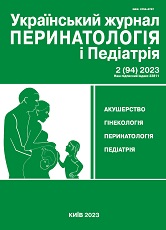Trends in major predictors of high-risk pregnancy
DOI:
https://doi.org/10.15574/PP.2023.94.22Keywords:
determinants, pregnancy, high risk, diseases, complications, integral assessmentAbstract
The sustainable development of the society of any country is largely determined by the health of pregnant women, which determines the viability and health of the offspring at all stages of ontogenesis.
Purpose - to conduct an analysis, change trends, and an integrated assessment (IA) of the main predictors of high-risk pregnancy (HRP) in Ukraine in 2010-2021.
Materials and methods. A comprehensive retrospective analysis, a general characterization of the dynamics and regional features of the integral assessment of the main predictors of HRP based on the data of the State Statistics Service of Ukraine and the Medical Statistics Center of the Ministry of Health of Ukraine, was carried out. Structured by individual components of the IA of the main predictors of HRP, it was carried out according to the generally accepted methodology of comprehensive assessment of the health status of the population based on integral indicators. The interpretation of the results of IA was based on the fact that the higher the integral indicator, the greater the risk of developing HRP. The methods of a systemic approach, structural-logical, epidemiological analysis were used. mathematical, modeling.
Results. Analytical data show that in recent years in Ukraine, the levels of maternal and perinatal morbidity and mortality have remained high despite a multidirectional trend, a significant part of which could have been prevented by identifying and minimizing predictors of HRP. The analysis of the state of the main predictors of the development of HRP revealed high levels of the birth rate of young (5.21‰) and older (7.86 ‰) women with an increase in their total contribution to the total birth rate from 9.5% in 2010 to 16.29% in 2021, the rate of growth is 71.5%, insufficient with a negative trend of coverage of pregnant women by dispensary supervision and examination by a therapist (90.7% in 2010 and 87.82% in 2021, the rate of loss is 3.9% and 90.83%, 89.51% and 9.9% respectively).
During this period, the frequency of diseases and complications of the gestational period remains high - anemia (26.4% in 2010, 24.75% in 2021, growth rate - 6.5%), diseases of the circulatory system (6.2-6.34% and 2.3%), diseases of the genitourinary system (14.05-14.03% and -2.4%), diabetes (0.17-0.96% and 452.9%), diseases of the thyroid gland (9.65, 9.2% and 1.76%), preeclampsia and eclampsia (2.31-2.1% and -9.1%), preeclampsia (6.65-6.7% and 0.8%) and venous complications (2.84-4.98% and 69.0%). The complex IA of the main predictors of HRP was carried out by dividing the regions into 3 groups - the Group I with a high risk of IA development (IA - 131.1-111.9%), the Group II with an average risk of IA development (106.5-92.0%) and the III group with a lower than average risk of HRP development (89.6-60.3%). The city of Kyiv is included in the 1st group of regions that require a detailed study and correction of the determinants of HRP, Vinnytsia, Poltava, Dnipropetrovsk, Kyiv, Chernihiv and Chernivtsi, to the 2nd group of regions with an average risk of developing HRP, that require strengthening of individual components of medical and social care for pregnant women - Volyn, Mykolaiv, Donetsk, Rivne, Kharkiv, Lviv, Zhytomyr, Cherkasy, Khmelnytskyi and Transcarpathian regions.
Conclusions. The toolkit of IA of the main determinants of HRP has been developed, that makes it possible to provide an objective assessment of them as a whole and by individual components across regions and timely identification of problems that require intervention.
No conflict of interests was declared by the authors.
References
Butkova OI, Zhabchenko AI, Kovalenko TM. (2019). Obstetric and perinatal risks in women after 35 years. 7-8 (128-129): 26-31. URL: https://mazg.com.ua/en/archive/2019/7-8%28128-129%29/pages-26-31/akusherski-ta-perinatalni-riziki-u-zhinok-pislya-rokiv
CDC. (2017). Centers for Disease Control and Prevention. Rates in severe morbidity indicators per 10,000 delivery hospitalizations, 1993-2014. Atlanta (GA). URL: https://www.cdc.gov/reproductivehealth/maternalinfanthealth/smm/rates-severe-morbidity-indicator.htm.
Davydova YuV, Lymanska AYu. (2022). Musculoskeletal pain during pregnancy: how to improve quality of life in high-risk pregnant women. Health of Ukraine: Obstetrics. Gynecology. Reproductologіа. 3-4 (49-50): 18-19. URL: https://health-ua.com/article/70940-abdomnalna-gsterektomya-ta-yakst-pslyaoperatcjnogo-vdnovlennya-aktcent-na-z.
IRZSMU. (2015). Methodological instructions for the practical lesson on the subject «Social medicine and organization of health care» for students of the 6th year of specialties «medical affairs, pediatrics» Topic: Comprehensive assessment of the state of health of the population based on integral indicators. Module 1 Content module 1 Zaporizhzhia: 8. URL: http://dspace.zsmu.edu.ua/bitstream/123456789/2830/1/KlimenkoVI15_Kompl_ocszdnnoip.pdf.
Malahova GS, Didenkul NV, Kuzmyn NV. (2021). High-risk pregnancy: effectiveness of personalized pregravid preparation and positive perinatal experience. 6 (62): 34-41. https://doi.org/10.18370/2309-4117.2021.62.34-41.
Petersen EE, Davis NL, Goodman D et al. (2019). Vital signs: pregnancy-related deaths, United States, 2011-2015, and strategies for prevention, 13 states, 2013-2017. MMWR Morb Mortal Wkly. Rep. 68 (18): 423-429. https://doi.org/10.15585/mmwr.mm6818e1.
Slabky GO, Zhylka NYa, Shcherbinska OS. (2021). State of reproductive health of women in Ukraine. Literature review. Reproductive Endocrinology. 4 (60): 65-69. https://doi.org/10.18370/2309-4117.2021.60.67-71.
Volkov OV. (2020). High-risk pregnancy: the anesthesiologist's view. Medical aspects of women’s health. 4-5 (133-134): 27-30. URL: http://journal.medlib.dp.gov.ua/wp-content/uploads/2021/01/Vagitnist-visokogo-risiku.pd.
Downloads
Published
Issue
Section
License
Copyright (c) 2023 Ukrainian Journal of Perinatology and Pediatrics

This work is licensed under a Creative Commons Attribution-NonCommercial 4.0 International License.
The policy of the Journal “Ukrainian Journal of Perinatology and Pediatrics” is compatible with the vast majority of funders' of open access and self-archiving policies. The journal provides immediate open access route being convinced that everyone – not only scientists - can benefit from research results, and publishes articles exclusively under open access distribution, with a Creative Commons Attribution-Noncommercial 4.0 international license(СС BY-NC).
Authors transfer the copyright to the Journal “MODERN PEDIATRICS. UKRAINE” when the manuscript is accepted for publication. Authors declare that this manuscript has not been published nor is under simultaneous consideration for publication elsewhere. After publication, the articles become freely available on-line to the public.
Readers have the right to use, distribute, and reproduce articles in any medium, provided the articles and the journal are properly cited.
The use of published materials for commercial purposes is strongly prohibited.

